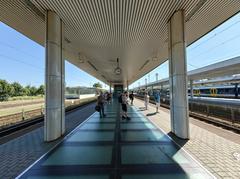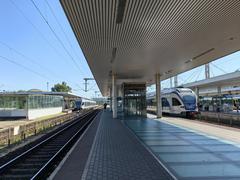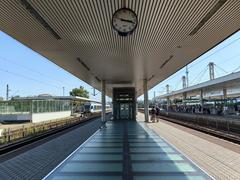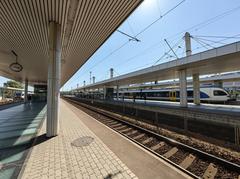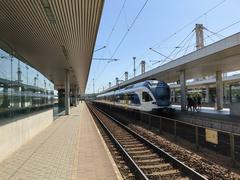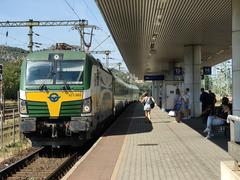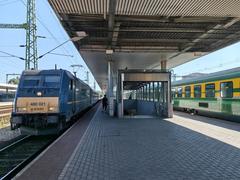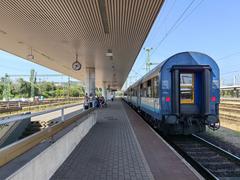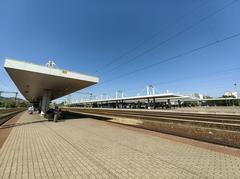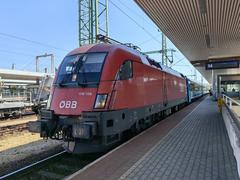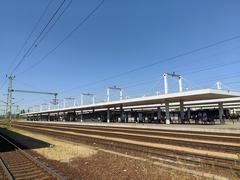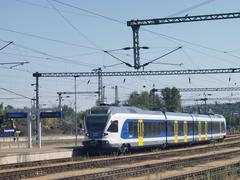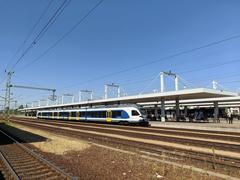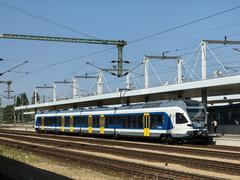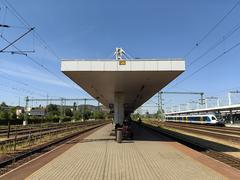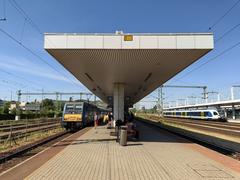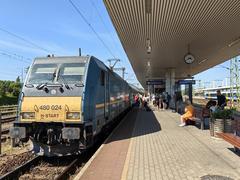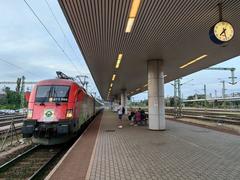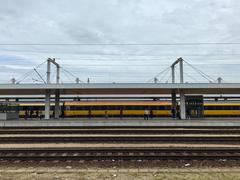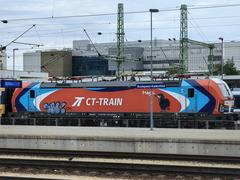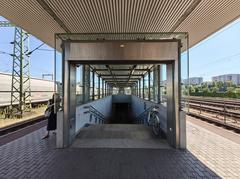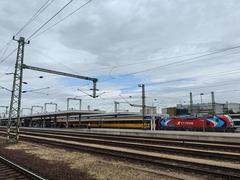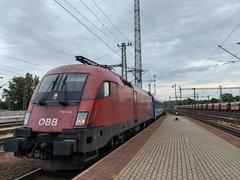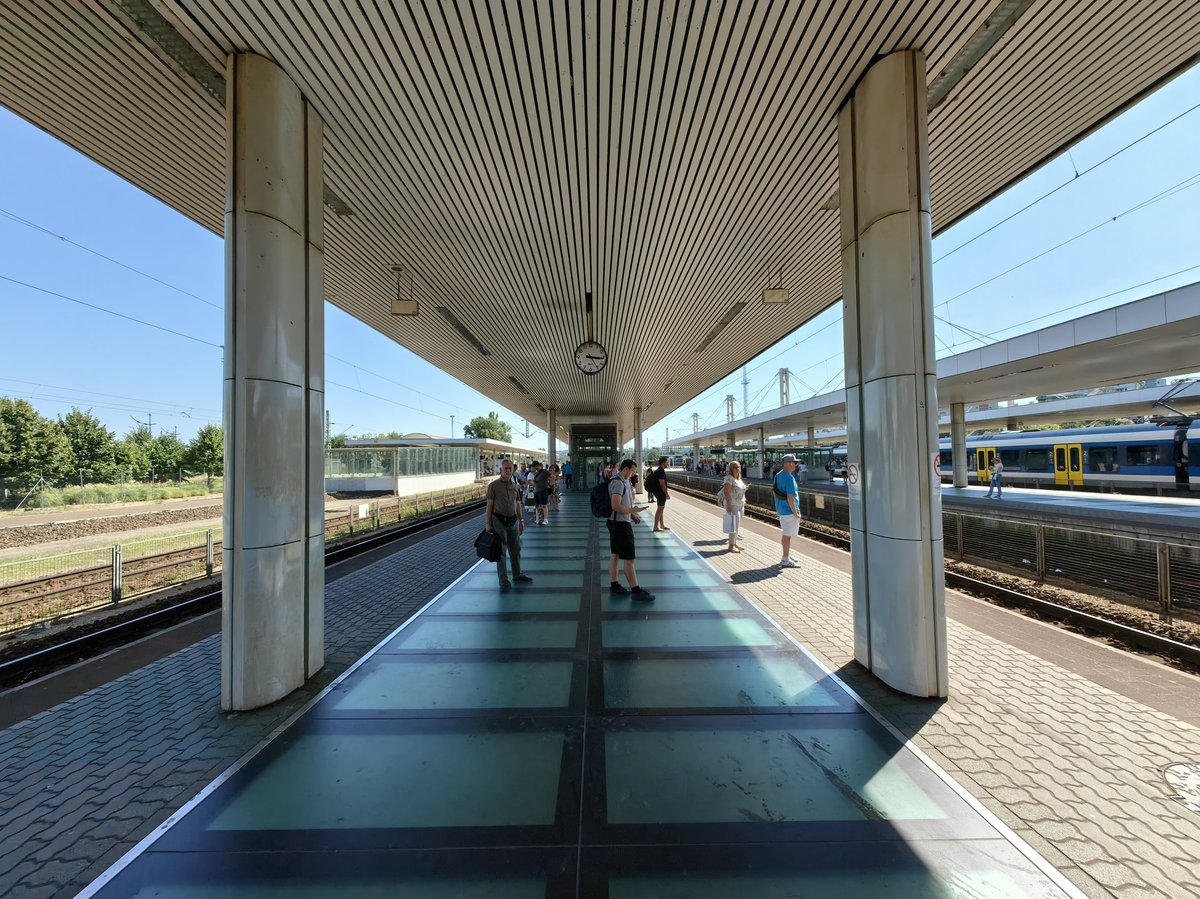
Kelenföld Railway Station Budapest: Visiting Hours, Tickets, and Essential Travel Guide
Date: 14/06/2025
Introduction: Kelenföld Railway Station and Its Significance
Kelenföld Railway Station—located in Budapest’s Újbuda district—is a premier transport hub and a vital piece of Hungary’s railway legacy. Since its inauguration in 1876, Kelenföld has evolved from a 19th-century terminus into a modern, intermodal transport center, connecting domestic and international rail lines with Metro Line 4, trams, and buses. The station’s transformation mirrors the city’s broader commitment to integrated, sustainable mobility and urban development.
With its blend of Austro-Hungarian architectural heritage and sleek contemporary structures, Kelenföld offers travelers more than just transit—it is a gateway to Budapest’s industrial history and vibrant present. Ongoing renovations will soon see the station house the Hungarian Technical and Transportation Museum, further cementing its status as a cultural landmark.
For up-to-date schedules, ticket purchases, and detailed visitor information, consult official resources such as Hungarian Railways (MÁV) and the Hungarian Technical and Transportation Museum (Funiq; We Love Budapest; Wikipedia).
Historical Overview
Origins and Development (1861–1877)
Kelenföld’s history began with the Austrian-owned Déli Railways Company constructing the Déli Railway Station and Gellért Hill tunnel in 1861. This 350-meter tunnel, Hungary’s longest at the time, linked Buda directly with southern Hungary and the Adriatic port of Rijeka. Kelenföld Station opened in 1876, strategically placed along this crucial corridor, with an original building twice the size of typical stations to reflect its importance (Funiq).
Architectural Significance
The station’s late 19th-century building is an example of robust, functional railway architecture. Its brick and stone construction, arched windows, and spacious waiting areas were designed for both passenger and freight traffic, anticipating Újbuda’s growth. Modern upgrades—including electrification (1932, 1980), track expansions, and new underpasses—have preserved heritage elements while supporting contemporary transit needs (We Love Budapest; Funiq).
Strategic Transport Role
The 1877 Southern Connecting Bridge linked Kelenföld’s rail lines with Pest and Eastern Hungary, establishing the station as a pivotal junction for routes to Belgrade, Pécs, Lake Balaton, Austria, and more. Kelenföld remains a key node for both domestic and international rail traffic (Funiq).
Wartime and Postwar Impact
World War II caused significant disruptions, with Kelenföld filling in for the damaged Déli Station and destroyed Southern Connecting Bridge. After partial restoration in 1946, the station resumed its central role in Budapest’s rail network.
Modernization and Urban Integration
Major upgrades between 1978 and 1987 added overhead lines, underpasses, and improved access. The opening of Metro Line 4 in 2014 further transformed Kelenföld into a fully integrated transport hub, connecting passengers seamlessly to the metro, buses, and trams (Funiq; Wikipedia).
Heritage Protection and Cultural Future
Recognized for its architectural and historical value, the original station building is now protected. Renovations are underway to house the Hungarian Technical and Transportation Museum, promising new exhibition spaces, model railway displays, educational programs, and a railway-themed playground (We Love Budapest).
Visiting Information
Opening Hours
- Train and Metro Services: Generally operate from 4:30 AM to midnight, with frequent departures.
- Museum: Expected to open late 2024; check the museum’s website for current hours.
Ticketing
- Train Tickets: Purchase at counters, ticket machines, or via the MÁV online system.
- Metro Tickets: Sold at purple and white vending machines near the metro entrance.
- Budapest Card: Offers unlimited public transport and attraction discounts (mapa-metro.com).
How To Get There
- Metro: Directly served by Metro Line 4 (M4), with step-free access.
- Trams/Buses: Multiple lines, including trams 1, 4, 6, and buses connecting to citywide destinations (Travel Dudes).
- Taxis: Licensed taxis are available; pre-book trusted services for convenience.
Accessibility
- Elevators, ramps, tactile paving, and multilingual signage ensure barrier-free movement throughout the station.
- Audio-visual announcements support travelers with disabilities.
Facilities
- Cafés, restaurants, supermarkets, and kiosks
- Free Wi-Fi and charging stations
- Luggage storage lockers (availability may vary at peak times)
- Clean restrooms and waiting areas
- Customer service desks and lost & found
Park & Ride
- Adjacent P+R car park with affordable daily and monthly rates (dailynewshungary.com).
Transport Connections
Rail
- Domestic: Direct trains to Lake Balaton, Pécs, Győr, Székesfehérvár, and more.
- International: Regular services to Vienna, Bratislava, Prague, Salzburg, Munich, Zurich, Ljubljana, Zagreb, and Bucharest (Rail Ninja).
Metro
- Metro Line 4 connects Kelenföld with city center stations like Szent Gellért tér, Fővám tér, and Kálvin tér.
Bus and Tram
- Major interchange for city and airport buses, and trams serving the river and other districts.
Nearby Attractions
- Gellért Hill & Citadella: Notable for panoramic city views and historic significance.
- Buda Castle District: UNESCO World Heritage area with museums and galleries.
- Rudas Baths: Historic thermal spa.
- Central Market Hall: Large indoor market for local food and crafts.
- Bikas Park & Szent Gellért’s Church: Green spaces and local culture within walking distance.
Practical Tips
- Peak Travel: Avoid morning (7:00–9:00) and evening (16:00–19:00) rush hours for a smoother experience.
- Language: English is widely spoken, but using basic Hungarian phrases is appreciated.
- Currency: Hungarian Forint (HUF) is the local currency; cards are widely accepted.
- Safety: Use official taxis and remain vigilant in busy areas.
- Sustainability: Kelenföld supports eco-friendly travel with recycling bins and Park & Ride.
FAQs
What are Kelenföld Railway Station’s operating hours?
4:30 AM to around midnight, with some services varying.
How do I buy tickets?
At station counters, vending machines, online via MÁV, or via platforms like Rail Ninja.
Is the station accessible?
Yes, with elevators, ramps, tactile paving, and multilingual information.
Are there luggage storage facilities?
Yes—secure lockers are available for short-term use.
What nearby attractions can I visit?
Buda Castle, Gellért Hill, Citadella, Rudas Baths, and Central Market Hall are easily accessible.
Visuals and Media Suggestions
- Photos of the historic and modern station buildings
- Images of Metro Line 4 and Park & Ride
- Maps showing Kelenföld’s location relative to city attractions
- Virtual tour links, if available
Alt text example: “Kelenföld Railway Station main entrance in Budapest”; “Budapest Metro Line 4 train at Kelenföld platform”; “Panoramic view of Gellért Hill and Citadella near Kelenföld Station”
Internal and External Links
- Budapest Metro Guide
- Budapest Card Benefits
- Budapest Public Transport System
- Budapest Historical Sites
Summary Table: Key Features
| Feature | Details |
|---|---|
| Location | 11th District, Buda side, Budapest |
| Visiting Hours | Approx. 4:30 AM – Midnight |
| Accessibility | Step-free, elevators, tactile paving |
| Rail Connections | Domestic and international (Vienna, Prague, Bratislava, Lake Balaton) |
| Metro Access | Direct to Metro Line 4, step-free, separate ticket machines |
| Bus/Tram Connections | Multiple city and airport lines |
| Facilities | Cafés, restaurants, supermarkets, luggage storage, Wi-Fi |
| Nearby Attractions | Buda Castle, National Gallery, Gellért Hill, Rudas Baths |
| Best Visiting Period | April–May, September–October |
Conclusion and Call to Action
Kelenföld Railway Station is more than a transit point—it’s a symbol of Budapest’s resilience, architectural heritage, and modern connectivity. Whether you’re a commuter, a tourist, or a history enthusiast, Kelenföld offers efficient links, accessible facilities, and proximity to some of Budapest’s most celebrated attractions.
For real-time updates and travel planning, consult the BudapestGO app, the official MÁV site, and Hungarian Technical and Transportation Museum. Download the Audiala app for live train schedules, ticketing, and travel alerts. Safe travels and enjoy your adventure through one of Budapest’s most important historic gateways!
Sources
- Visiting Kelenföld Railway Station: History, Tickets, Hours & Travel Tips, 2024, Funiq (https://en.funiq.hu/3385-kelenf%C3%B6ld-railway-station)
- Kelenföld Railway Station Visiting Hours, Tickets, and Guide to Budapest’s Historic Transport Hub, 2024, mapa-metro.com (https://mapa-metro.com/en/Hungary/Budapest/Budapest-Metro-map.htm)
- Kelenföld Railway Station: Visiting Hours, Tickets, and Travel Guide in Budapest, 2024, Rail Ninja (https://rail.ninja/station/kelenfold)
- Visitor Experience and Practical Tips at Kelenföld Railway Station: Visiting Hours, Tickets, and Nearby Budapest Historical Sites, 2024, Travel Dudes (https://traveldudes.com/budapest-travel-guide-what-to-know/)
- Kelenföld Railway Station, Wikipedia (https://en.wikipedia.org/wiki/Kelenf%C3%B6ld_railway_station)
- Budapest’s Historic Railway Stations, Wikipedia (https://en.wikipedia.org/wiki/Rail_transport_in_Hungary)
- Budapest Kelenföld Station Train Museum, We Love Budapest (https://welovebudapest.com/en/article/2021/02/16/budapest-kelenfold-station-train-museum)
- Parking in Budapest: Fees Rise 2025 Tips, Daily News Hungary (https://dailynewshungary.com/parking-in-budapest-fees-rise-2025-tips/)
